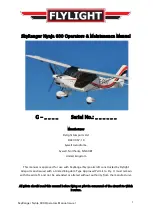2141 ICON Way, Vacaville, CA 95688
‐
Tel: 707.564.4000
SERVICE LETTER
SL-042820 REV A
ICA009717-E
PAGE 4 of 9
substrates, resulting in a loss of strength and reliability. Utilize the following methods to
prevent temperature damage
b.
Keep the maximum output air temperature of the heat gun below the threshold of
damage temperature of the substrate and any surrounding components (i.e. 200 °F)
c.
Use any available technologies to (infrared, temperature sensitive paint, etc.) monitor
the temperature of the nearby substrate during the operation. It should always be
below the threshold temperature (i.e. 200 °F)
d.
Mask adjacent components and substrates with thermal barrier (silicone sheet or
aluminum foil mask) to minimize heat transfer to unintended areas.
2.
Remove any remaining adhesive by sanding with aluminum oxide paper until the base
laminate is exposed. Do not damage the laminate.
3.
Proceed with progressive inspection methods as required to ensure no damage has occurred
during the removal of the bond. Inspection methods may include visual, magnified visual,
borescope, tap testing, ultrasonic, etc. If required, carefully remove the surface protection by
abrasive methods. For paint, primer, and bodywork removal, sand surface with aluminum
oxide paper until the laminate is exposed. Do not damage the laminate.
4.
Wipe areas marked in red below on Figure 1 the RH and LH Seawing (TM) with isopropyl
alcohol and a lint-free cloth. Allow 15 minutes to dry.
Figure 1 Bonding Area
5.
Place 2
Ea .032”
thick washers on the Seawing Studs and test fit Seawing tip for alignment
with the attachment bolt. Adjust washer thickness on each Stud until mounting bolt hole
aligns and there is a consistent reveal around the Seawing. These are used as temporary
shims.


















